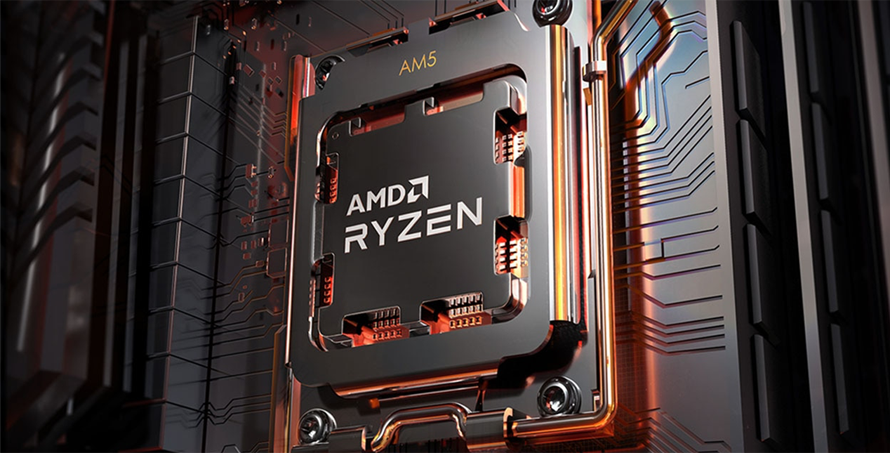AMD launched its Ryzen 8000G-series accelerated processing units (APUs) with Zen 4 and Zen 4c cores for desktops just a little over a month ago and apparently the company is prepping to release 35W versions of these processors shortly. At least, some of AMD’s partners are already listing some of the company’s Ryzen 8000GE-series products as supported by some of their motherboards on their website (as noticed by @harukaze5719). This is not official information from AMD, so take it with a grain of salt.
| Model Number | Cores | Frequency | Wattage | L3 | Silicon | Row 0 – Cell 6 |
| Ryzen 7 PRO 8700GE | 8 Zen | 3.65GHz | 35W | 16MB | Phoenix | Row 1 – Cell 6 |
| Ryzen 5 PRO 8600GE | 6 Zen 4 | 3.9GHz | 35W | 16MB | Phoenix | Row 2 – Cell 6 |
| Ryzen 5 8500GE | 2 Zen 4 + 4 Zen 4c | 3.4GHz | 35W | 16MB | Phoenix 2 | Row 3 – Cell 6 |
| Ryzen 5 PRO 8500GE | 2 Zen 4 + 4 Zen 4c | 3.4GHz | 35W | 16MB | Phoenix 2 | Row 4 – Cell 6 |
| Ryzen 3 8300GE | 2 Zen 4 + 2 Zen 4c | 3.5GHz | 35W | 8MB | Phoenix 2 | Row 5 – Cell 6 |
| Ryzen 3 PRO 8300GE | 2 Zen 4 + 2 Zen 4c | 3.5GHz | 35W | 8MB | Phoenix 2 | Row 6 – Cell 6 |
For now, Asus lists six AMD Ryzen 8000GE processors with built-in Radeon RDNA 3 graphics and a 35W thermal design power with four of them being Ryzen Pro 8000GE-badged offerings and only two are regular Ryzen 8000GE APUs. At least, as far as the Ryzen Pro 8000GE family is concerned, it looks complete with the eight-core Ryzen 7 Pro 8700 GE, six-core Ryzen 5 Pro 8600 GE, six-core Ryzen 5 Pro 8500 GE, and quad-core Ryzen 3 Pro 8300 GE. By contrast, the non-Pro family members listed by Asus includes the six-core Ryzen 5 8500 GE, and quad-core Ryzen 3 8300 GE.
To reduce power consumption of its Ryzen 8000GE products to 35W, AMD lowered their clocks, but it looks like they preserve core count and cache sizes of their regular counterparts that feature a thermal design power of 35W.
| Processor | Model Number | Frequency | Wattage | L3 | Core | Stepping |
| Ryzen 7 | Ryzen 7 PRO 8700GE | 3.65GHz | 35W | 16MB | 8 | ? |
| Ryzen 7 | Ryzen 7 8700G | 4.2GHz | 65W | 16MB | 8 | B2 |
| Ryzen 7 | Ryzen 7 PRO 8700G | 4.2GHz | 65W | 16MB | 8 | ? |
| Ryzen 5 | Ryzen 5 PRO 8600GE | 3.9GHz | 35W | 16MB | 6 | ? |
| Ryzen 5 | Ryzen 5 8600G | 4.35GHz | 65W | 16MB | 6 | B2 |
| Ryzen 5 | Ryzen 5 PRO 8600G | 4.35GHz | 65W | 16MB | 6 | ? |
| Ryzen 5 | Ryzen 5 8500GE | 3.4GHz | 35W | 16MB | 6 | ? |
| Ryzen 5 | Ryzen 5 PRO 8500GE | 3.4GHz | 35W | 16MB | 6 | ? |
| Ryzen 5 | Ryzen 5 8500G | 3.55GHz | 65W | 16MB | 6 | B2 |
| Ryzen 5 | Ryzen 5 PRO 8500G | 3.55GHz | 65W | 16MB | 6 | B2 |
| Ryzen 3 | Ryzen 3 8300GE | 3.5GHz | 35W | 8MB | 4 | ? |
| Ryzen 3 | Ryzen 3 PRO 8300GE | 3.5GHz | 35W | 8MB | 4 | ? |
| Ryzen 3 | Ryzen 3 PRO 8300G | 3.45GHz | 65W | 8MB | 4 | B2 |
| Ryzen 3 | Ryzen 3 8300G | 3.45GHz | 65W | 8MB | 4 | B2 |
It is possible that AMD plans to address business desktops with Ryzen Pro 8000GE-series processors first as these systems tend to be small and require low-power CPUs and only then release the full stack of its Ryzen 8000GE-series non-Pro APUs. Traditionally, AMD’s Ryzen Pro APUs support ECC memory, memory encryption, secure boot, DASH remote management capabilities, and Microsoft Pluton.
Just like in case of regular Ryzen 8000G-series APUs, it looks like the Ryzen 5 8600G and Ryzen 7 8700G are expected to employ the premium Phoenix silicon, boasting up to eight Zen 4 cores and Radeon 780M graphics, whereas Ryzen 3 8300G and Ryzen 5 8500G models rely on AMD’s Phoenix 2 silicon, featuring up to 6 cores and Radeon 740M graphics.AMD’s Phoenix will naturally provide superior performance for both general-purpose computing and graphics tasks as well as incorporates the Ryzen AI accelerator to handle machine learning workloads.
